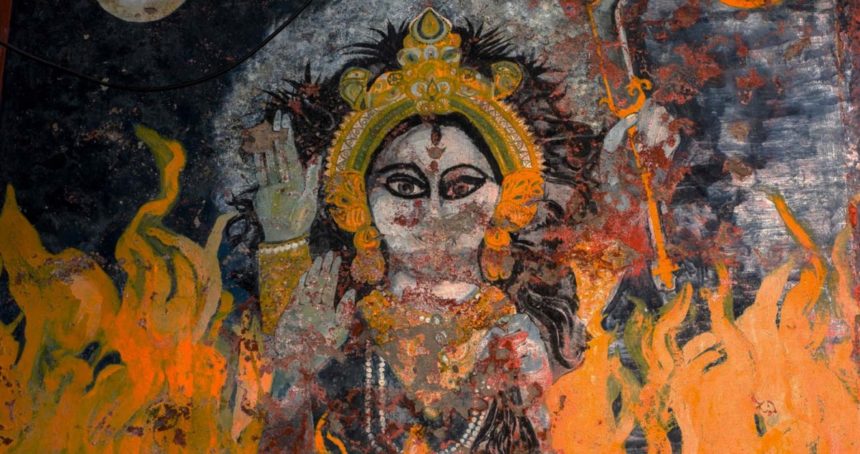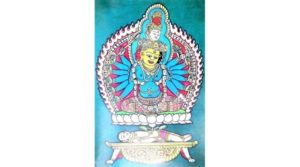Kubjikā̄ Mata, whose sadhana has nearly vanished from the popular Shakta practice owing to the secretive nature of the path, is a powerful form of the Devi whose grace greatly accelerates the progress of the serious sadhaka.
The hunchbacked goddess

Mark Dyczkowski was born in London in 1951. At the age of 17, he felt an inner urge to travel to India and explore its various mystical and knowledge traditions. He lived at the Ashrama of a Guru for six months and eventually joined the Banaras Hindu University studying Sanskrit, Indian philosophy with a specific emphasis on Kashmiri Saivism. Later he even met Swami Lakshman Joo, arguably the most authoritative name in the tradition of Kashmiri Saivism, and was initiated by him. During this time he was gifted the copy of a manuscript on Tantra which dealt with a rare goddess, whose worship had faded from mainstream India. In 1980 when Mark was travelling to Nepal, drawn by the rich Tantric traditions, he came across a whole bunch of manuscripts dealing with the liturgy of this extremely secretive deity, and not only manuscripts but he was also introduced to a thriving subculture of upasakas who worshipped this rare and powerful form since the 12th century, when this Tantric upasana was introduced to the Himalayan kingdom. The name of the Goddess was Kubjikā̄ or the hunchback. Mark believed he had a vision of the Goddess where he was asked to bring this information out in the form of a book. Collating, reading, translating those manuscripts over 10 years, eventually Mark Dyczkowski was able to produce fourteen volumes on the Manthanabhairava Tantra.
Transmission
Scholars believe that Kubjikā̄ was originally a part of the Kashmiri tradition in another name and from there, this vidya was transmitted probably by the influence of the Nath Yogis like Matsyendra towards Nepal. There is also a view that the Kubjikā̄ Mata had multiple streams of which most have faded today, and some of them have references to Gurus older than the Naths, who were only channels of transmission. However today, as per the Kubjikā̄mata Tantra, this vidya is universally regarded as pertaining to the paschimAmnAya.The term “amnaya” is used to denote distinct groups of scriptures within the Kaula Agamas that share a common affiliation to a single tradition and originated from or propagated towards a fixed direction. There are five such amnayas, four in the cardinal directions and one upwards. Sometimes these are also equated with the five vital breaths inside a human being. PaschimAmnAya refers to the Western direction, is synonymous with the vyAna vayu and it is in this tradition that Devi Kubjikā̄’s śāsana is unquestionable.
The Newars, particularly the kings of the Malla dynasty and their priests were all believed to have worshipped Devi Kubjikā̄ as a tutelary deity and it was around them that a thriving cult of Kubjikā̄ upasakas survived in Nepal since the 12th century, while the goddess had almost been forgotten in the land of her origin. However, no official temple of Kubjikā̄ was ever created, neither is she as well known as some of the other Tantric forms of Devi like Kali. Utmost secrecy was a paramount feature of Kubjikā̄ Mata. There is a story passed down orally that a certain prince of the Malla dynasty had violated the modesty of a young girl whose father was an exalted devotee of the goddess and this defilement incurred the wrath of Devi Kubjikā̄ on the royal family. She removed her protection and the line of Mallas came to an end when Prithvi Narayan Shah of the Gorkha Kingdom invaded Kathmandu in 1768-69 CE at the Battle of Kirtipur.
Iconography

Like in most forms of Shakta puja, Devi Kubjikā̄, it is believed, had different iconographies according to the specific nature of her emanation and its propagation in a particular cultural setting. One of her earliest forms, as depicted in the texts, describes her with six faces, worshipped along with a Pañcamukha Mahadeva and her body is adorned by six nagas: Karotaka as a waistband, Takshaka as an ornament between her chest and waist, Vasuki as a garland, Kulika as her earrings. In her hands, she holds a skull, a king-cobra, a crystal-bead rosary, khatvanga (skull-topped rod), sankha, book, trishula, mirror, khadga, a necklace of rare gems, ankusha, and a bow. Her complexion is like that of a Kunda flower. In another form where she is known as Vakreshvari her six faces are known as parA, mAlinI, mAtR^ikA, kAlikA, tripurA and khecharI.
The Esoteric
The word Kubjikā̄̄ in Sanskrit means Hunchbacked. Mark Dyczkowski describes in his tome that she is also known as Kubjī, Kujā, Kujī, Khañjinī – the Lame One; Vakrikā or Vakrā – the Crooked One; Ciñcinī – the Goddess residing in the Tamarind tree; Kulālikā – the Potteress; Ambā or the vernacular forms as Avvā, Anāmā, Laghvikā; and, most common of all as Śrī – the Royal One. Her nature is best described as a secret among secrets – guhyAti guhya, and her influence on royalty is well attested by the manner in which the Newar Royal family had a close association with her, and yet her upasana remained hidden from the masses. Only the initiates passed it on from one generation to the next. But why is she called crooked? Probably of all feminine Divine forms in Hinduism, Devi Kubjikā̄ is the clearest personification of the human ego or aham, which controls our very existence and creates a sense of individualization. What is aham in a normal human being, is also the “sleeping” or unawakened state of this Kuṇḍalinī Shakti – that residual supernatural force which lies dormant inside the human body and can be activated by serious Yogic/Tantric practices. Once awakened in a controlled manner, this Shakti accelerates an individual’s spiritual evolution at a breakneck speed. Therefore, the paths that required utilizing the force of Kuṇḍalinī were always extremely Gurumukhi because just as a powerful Kuṇḍalinī awakening can take an individual into a completely different sense of reality, the same way the smallest of mistakes can derail the seeker and keep him trapped in a well of delusion, or worse throw him down into a miserable condition far worse than what he had initially started from. This tremendous Shakti was revered, respected and treated with adequate caution among the initiates. A fully awakened Kuṇḍalinī shoots upwards and merges in the Akula – one who is beyond the Kula or Shiva, while during ordinary conditions she stays right inside the body but perfectly hidden from our normal awareness. After all, no human being is aware of his own I-sense or aham when he goes about his daily ordinary functions yet without the aham, there would be no individual in the first place. This phenomenon of being all-pervasive yet perfectly hidden in the background is also the core nature of Kubjikā̄.
A story goes that once Shiva came to hold her hand and the Devi was unsure and reticent for a moment and in that condition of hesitation became hunched. That is how Kubjikā̄ or Vakreshwari came into existence. Spiritually, Shiva represents the ultimate Divine state, but this consciousness cannot enter into or reside inside our fragmented, ignorant selves which we are in the normal condition. That is why the concept of tattwashuddi or adhara–shuddhi is very important. Adhara simply means the receptacle – mind and body. Until they are purified they cannot hold the Divine inside. This same idea also comes to us from the Ramayana when Ravana decides to bring Kailasa to Lanka. Kailasa is the physical representation of the higher consciousness of Sahasradala where Shiva or the Divine resides. Lanka is the Muladhara that governs our physical existence of five senses and roots us to the earth.
A great purification of the Muladhara can bring tremendous material riches and benefits, just as the descriptions of Lanka noted how the kingdom was flooded with gold and material opulence. But the standard spiritual path is for the Shakti to rise from Muladhara and finally reach Kailasa, not the other way round, and certainly never an absurd cohabitation of the Divine with the limitations of the lower chakra. Naturally, Ravana met with disaster when Shiva pressed his foot on to the Raksasa Lord’s hands and pinned him down for a thousand years! In the same way, the normal aham that works in our ordinary life cannot suddenly give up its ignorant ways and turn itself over to self-annihilation in the Divine. An ordinary man if he were suddenly to come in contact with an experience of an otherworldly nature, would first be rattled, and then use his mentality to justify what may be incorrect about it, or labour under stressful thoughts of why a spiritual turn may not be right at this moment given that such may hamper with whatever worldly dharma he is currently engaged in. Valid or invalid, this is exactly how the aham works. It will never ever willfully sign its own death warrant, and it knows exactly how to convince the mind and emotions to choose a solution where its control over the individual remains untarnished. This is why Kubjikā̄ Shakti hunched herself backward and earned the epithet Vakra, when Shiva came to hold her hand, for this is the most natural human reaction when faced with something extraordinarily beyond out mental conceptions. But that is only the beginning when the real journey has not yet started. By upasana of this form, eventually, the seeker experiences how Kubjikā̄ – the unremarkable hunchbacked lady – suddenly starts straightening and shooting upwards piercing through the chakras and changing the seeker’s subjective experience of the world around until she merges into Akula. Whenever there is someone who experiences the effects of a Kuṇḍalinī jagaran, irrespective of the path, time, place or culture, it’s always by her sanction alone that it must transpire, even if the individual may have never heard of Kubjikā̄ Devi.
When fashioning this delicate and transformative journey, the seeker is forced to undergo changes in his mind and emotions, his daily routine and interactions in order to safely sustain the power rushing through his body. The human adhara is like raw clay and Kubjikā̄ creates the pot that can bear her strength and power sustainably. Thus she is called Kulālikā – the Potteress. Additionally, when Kubjikā̄ passes beyond the Manipura chakra she starts manifesting her powers most visibly, and the first is an unmistakable lordliness in the seeker. Kubjikā̄ is therefore also known as Śrī – the Royal One. In Tantra sadhana, every path has a Kulavṛkṣa, a tree that represents the devata. For Kubjikā Mata it is the tamarind tree.
The nine great Nath Yogis were believed to be worshipers of Kubjikā and it is through them that the upasana of this form spread across India, even to the South. Now, of course, the Devi is neither remembered except perhaps in some esoteric circles nor do we find any temples dedicated to her. Coming across a Kubjikā̄ sadhaka is extremely rare. The secrecy involved in this sadhana ensured that while Kubjikā̄ was highly revered and equally feared, she was never a deity for the public. Even in places where a strong cult of traditional Kubjikā̄ upasakas kept the vidya alive, we find almost no trace of temples or public festivities associated with her. A good reflection of the fact that even when theoretical knowledge about Kuṇḍalinī is only a click away on Google, the real experience is still highly unusual, extremely rare and defies set formats or easy thumb-rules. Therefore, all ‘new-age’ ideas of mass Kuṇḍalinī awakening are perfect nonsense because the energy of Kubjikā is guhyAti guhya.

Leave a Reply